| Label | Label Description | Images |
| Camden |
This is
one of many paste-over labels on British records for export to
Australia. In this case, they are pasted over Vocalion records. Thanks to Bill Dean Myatt for providing the label image. |
|
| Cameo |
The British version of Cameo dates from
1916 and were sold by Gilbert's of Sheffield for 1/-. They were all
paste-over labels using obsolete Regal records. The paste-over label
does not show any artist names, just a description of the type of
performance. I believe that the Cameo label could be pasted over
original Columbia, Columbia-Rena and Phoenix records as well. Sometimes,
the label is just a half-label pasted over the original "Regal" name,
and so showing all the details; it is believed these were exported to
Australia. Thanks to Bill Dean Myatt for providing the label photo. |
|
| Canterbury | I know absolutely nothing about the Canterbury record. It is a "paste-over" label only as far as I am aware, but I am basing this on the only example I've seen which is pictured here. The Canterbury label is only a partial one, being pasted over the upper portion of a "Valkyrie" record. As such, there is no catalogue for Canterbury. |
|
|
Capitol (sold in Australia) |
Another paste-over of old stock for export to Australia, I believe
Capitol labels were pasted over Parlophones (and possibly Columbias)
from the 1920s, though later the sourced Parlophones were actually
Australian. |
 |
|
Capitol |
The well-known label of the 1950s (and later) was first pressed by
Decca, then later by EMI. The source recordings were always US Capitol
and all issued rcordings were American. The earliest UK capitols are the gold on dark brown style (always Decca pressings), later changing to gold-on-purple; the latter may be found as both Decca and EMI pressings. There were also Capitol Junior records (this example here is an EMI pressing) of children's material. Recently, an image of little known (to me) Classical series was sent to me by Bill (see last image, right). This is a Decca pressing. Thanks to Bill Dean-Myatt for the images. |
 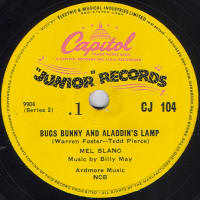 _small.jpg) |
| Carnival 1930 | Thanks to Bill Dean-Myatt for the label scan. |
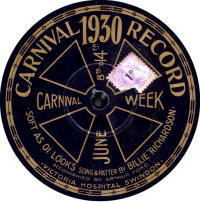 |
| Celebrity |
Celebrity Records were
available during 1929 and 1930, a short lived venture by Celebrity
Gramophones Ltd of 82, St Thomas Street, London, who made gramophones
from 1927 until about 1932. Celebrity records used a 4300 catalogue series and used U. K. masters from Worldecho and Dominion and U.S. masters from Grey Gull and QRS. They are extremely difficult to find. Most dance records seemed to be issued as by "Celebrity Dance Orchestra". |
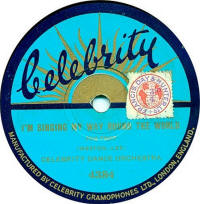 |
| Cellutone | Please e-mail me with details of ANY of these records. Also a label scan | |
| Champion-Gamage |
This was an oversized 10"
disc pressed from Grammavox masters for sale in A W Gamage's department
stores from 1911. The catalogue series ran from G-1 to at least G-180. Thanks to Adam Miller for providing the label scan. |
_small.jpg) |
| Chappell |
Chappell and Co were a music publishers
in London. However, just before WWI, they ventured into the record
business. The label bearing the company's name used masters from the
Sound Recording Company and was very short-lived. It was available in
10" and 12" sizes, the 12" being labelled "Chappell De Luxe".
In the post-WWII era, Chappell records
appeared again, containing Library music. The yellow one was recorded & manufactured by Decca; this and the other examples I have are shellac pressings. The blue may have been made by Oriole; these are either shellac or vinyl. The red was an EMI product, usually pressed in vinyl.
|
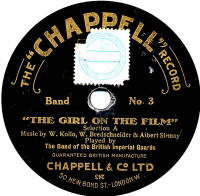 Pre-WWI label  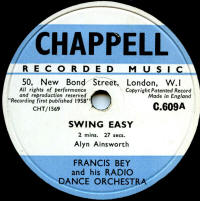 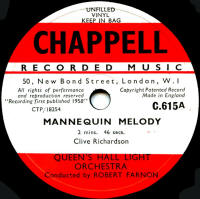 Libraray music labels |
| Cherubini Society |
The Cherubini Society was formed by Mr. M.G. Thomas (this isn't me, or a relative - ed. ) of Westbourne Park Road, London W.2.. The records issued under this name date from late 1949. They were 12" discs numbered CS-1 to CS-8.
Thanks to
Bill Dean-Myatt for the label scan. |
|
| Children's Special Service Mission |
Produced by Parlophone and numbered in their special PO-series. There are belived to be just two of these, numbered PO-33 & PO-34. These were recorded on October 5th, 1932 and were kept in the catalogue until late 1956.
Thanks to
Bill Dean-Myatt for the label scan. |
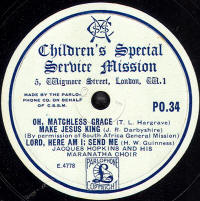 |
| Chins | This label was manufactured in Engalnd for export to the Carribean. |
 |
| Christian Radio And Television |
I'm guessing this dates to the 1950s, but apart from that I know nothing about it, though obviously it is one of a series of issues. Frank Andrews reports knowledge of two records, both recorded & manufactured by Levy's Sound Studios. Levy's studios were in London, and manufactory was in Aston Clinton, Bucks.
Thanks to
Bill Dean-Myatt for the label scan. |
|
| Cinch |
1913,
when Cinch Records were launched, was the start of a major cut-price war
between the major record companies who were trying to regain the ground
lost to recent, cheaper, newcomers into the disk record market. These
newcomers were the Coliseum and Scala records introduced in 1912 by the
Beka Co. of Germany, selling at 1/6 (7.5p). Cinch records were
manufactured by The Gramophone Company, often using existing Zonophone
matrices. They were sold at 1/1 (about 6p), undercutting the German
records, and offered top artists, albeit under pseudonyms in many cases
(with the usual exception of the ubiquitous Billy Williams!).
The advent of the first World War, which halted cheap German imports, removed the competition which had resulted in the creation of Cinch and other similar record labels, but it had become so popular that it wasn't until January 1916 when the last Cinch supplement was published. The catalogue numbers ran from 5001 up to 5462. Label listing: The late Arthur Badrock's listing of this label is now available from the CLPGS. (Booklet No. RS 30) |
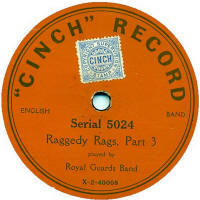 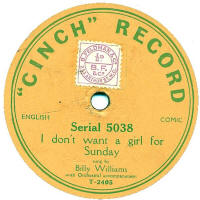 |
| Cinecord |
Cinecord
was made by British Homophone
Ltd for The Cinecord Co. Ltd which was formed in August 1935, and based
at 49, Whitfield Street, London W1. The company seems to have
dissapeared by November 1935 but it wasn't struck off the Companies
Register until 1951. The majority of the masters had already been issued on BH's Sterno label. The records were not intended for sale to the general public, but, based on the announcement on a special Cinecord record, they were sold in cinemas for 9d each. It is not known if they were ONLY sold in Odeon group cinemas, or whether they did actually make it into general shops. They are not particularly scarce, and some of the Cinecord issues are easier to find then the equivalent Sternos; this late period of Sterno record can be very hard to find. With the exceptions of the first issues, the bands/performers are anonymous on Cinecords. The catalogue started at O2 and only ran up to O21. (The first one was labelled OD1 (i.e. Odeon).) |
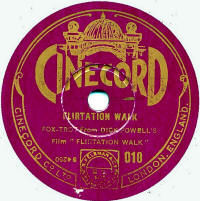 |
| Citizen |
Citizen records are rare and rather mysterious. They first appeared in
1916 and were a Crystalate product using a 3000 catalogue series (see
first pic). By 1920 they were being produced by Vocalion and the label
changed to a light & dark mauve design (see second example)
before changing to the red and gold label seen here (third scan). The
Vocalion-produced Citizen records used a 3-digit series starting
at 501 and running into the late 800s before
ceasing in the mid 1920s. As you can tell, little is known about the label, the size of the catalogue, or for whom they were produced, though they seem to turn up most often in the Manchester disctrict. The Vocalion period used the usual masters, apart from UK recorded Vocalion matrices, there are Gennett and Vocalion masters from the U.S.
|
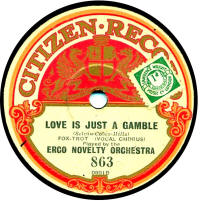 |
| Clarion |
The English Clarion label is primarily remembered nowadays as a
producer of cylindrical records. However they made two types of disc
record, an early vertical-cut groove one and one with a standard groove, Both
are very rare, and the label designs on both are the same. |
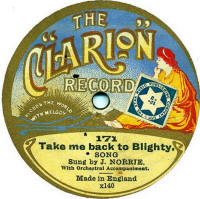 |
| Classic Jazz |
This label was produced for the Sheffield Rhythm Club and
probably dates from the 1950s. I would be interested in any other examples, in order to produce a listing of this label. The reverse side of this issue is master WHC-150; Mamie's Blues, by Tony Short (piano solo). Thanks to Richard Prout for the label scan. |
 |
| Cleveland |
Cleveland was a jazz club label produced by the Cleveland Jazz
Club of London from 1949, and concentrated, at least initially, on
recordings by Freddy Randall & his Band. The records cost 7/6 and were
only available direct from the Club. I believe they were precorded by
Gui de Buire. Eight sides are known, numbered FR-1 to FR-8 and it may be
that these are the only issues, and once Freddy Randall got a contract
to record for Parlophone, no more Cleveland records were produced? Thanks to Bill Dean-Myatt for the label scan. |
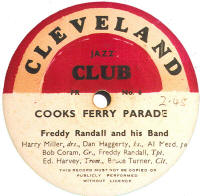 |
| Climax |
First appeared in Britain in 1901, Climax, in both 7" and 10"
format (single-sided) were prodcued in America by the Columbia
Phonograph Company, but the label name was changed to Columbia by later
in 1902, hence Climax records were only available in Britain quite
briefly, and very early, so it is not surprising that I've never seen one! Since Columbia had no manufacturing facilities in the UK, These Climax records would all be manufactured in the US and exported to the UK. Hence there's no difference between the US issues and the UK ones visually. I don't know which of these label styles comes first, or if they represent different markets. Note though, the metal centre ring which stregthened the record's centre hole. I have found the images here on the internet at http://phonograph78.blogspot.co.uk |
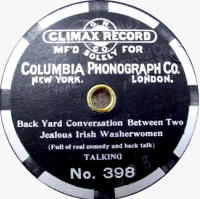 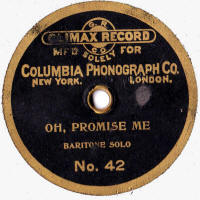 |
| Clipper |
This record was manufactured in England for a record company in
Hong Kong. Thanks to Bill Dean-Myatt for the label image. |
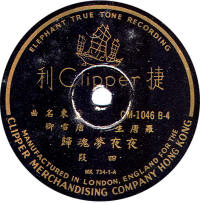 |
| Clover |
This would appear to be a product of the Francis, Day & Hunter
organisation and dating to the late 1940s. The catalogue series was in
an S-1000 range and the matrices in a TL-series. Any further information
would be gratefully received. The song in this image was puiblished in
1948, which helps to date this record. (Thanks to Bill Dean-Myatt for
this information.) Thanks to Norman Field for the label image. |
|
| Coliseum | Coliseum records first appeared in 1912, offering popular music at a budget price. Numbering started at 100 and reached 2059 in early 1927 when manufacturing was discontinued. According to contemporary advertisements, the sole manufacturers were Cooper Brothers Ltd, of 45 & 63 City Road & 17, Clerkenwell Road, London EC 1, with branches in Manchester & Cardiff. Prices shown are 2/6 (12.5p) for the standard 10" disc. English matrices were from Vocalion and US matrices from Gennett (initially and finally) with Vocalion "in between", plus a few from Emerson. |
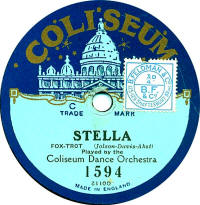 |
| College Chords |
A privately produced record for Newbold
College in Berkshire. Thanks to Bill Dean-Myatt for the label image. |
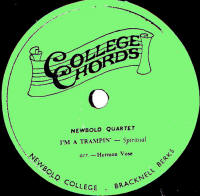 |
| Colonial / Colonial Perophone |
Colonial and Colonial Perophone
records were manufactured in Germany by Homophon in the period
immediately before WWI. They were made on behalf of Lockwoods of City
Road London, for export only. This is generally believed to mean they
were exported to Australia.
Thanks to Adam Miller for providing the Colonial label scan, and to Bill Dean-Myatt for the Colonial Perophone scan. |
_small.jpg) |
| Columbia / Columbia-Rena |
Columbia
disc records first appeared in England in 1902 following the American
Columbia Phonograph Company setting up a branch office in London in
1900, initially importing their wax cylinders, and then, from 1902,
their Climax records before introducing the Columbia label later the
same year. All the early records were recorded & manufactured in the US
and were single faced initially, but double-faced records were
introducted from 1904. In June 1906, Columbia started manufacturing records in England when they opened a factory in Bendon Valley, Garratt Lane, Wandsworth, London. In 1910 they took over Louis Sterling's Rena Manufacturing company and the label name changed to be "Columbia-Rena" until 1915 when the Rena name was dropped. In 1917, the Columbia Graphophone Company was set up in London and, although a subsidiary of the American Columbia Phonograph Company, was much more successful, eventually taking full control of the American company. Due to difficult trading conditions in the early 1930s, Columbia merged with the Gramophone Company to form E.M.I.. The Columbia name continued to be used on records until the 1970s. More details and label examples on the linked page (click on label name in the left-hand column), along with a listing of the CB- series. Listings of at least some of the various Columbia series are avalable from the CLPGS. |
 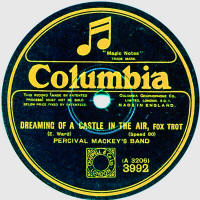 |
| Comet |
This was a "paste-over" label, presumably a way to job off old stock of
records. The example here was pasted over a pre-WWI Winner. Thanks to Bill Dean-Myatt for the label image. |
 |
| Concert |
This was an American label made by Leeds & Catlin and advertised as
available in Britain during April and May 1906 for 2/- each. It is
possible that further advertising of this label in the UK was quashed by
The Gramophone Company as their 10" records were already labelled
"Gramophone Concert Record". Indeed, it is possible that none actually
made it on sale in the UK at all. The image seen here is of a Leeds and
Catlin "Concert" record as sold in the US, but if any did make it to
Britain, they would have looked identical. There was also a label called "Concert - The Quality Record" on sale in Britain in the 1950s, thought to have been manufactured by Oriole Ltd, but as neither Frank Andrews or I have seen an example, this is just speculation. |
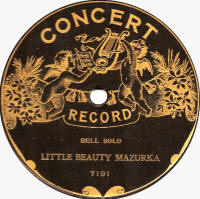 |
| Concert Artist |
The Concert Artist Record Company, a subsidiary of W.H. Barrington-Coupe
Ltd, was based at High Holborn, London during 1955 & 1956 which is
probably when these records date from. They cost 5/6 for 10" and 8/11½ for
12" 78rpm records. Most of their recordings were issued in 45rpm and 33rpm
formats. It is not currently known who recorded and manufactured the
records. Thanks to Bill Dean-Myatt for the label image. |
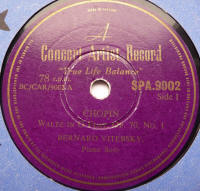 |
| Conqueror |
This was a pre-WWI record manufactured by The
Disc Record Company, using old Nicole masters, but using solid stock
material, not the Nicole "unbreakble" type. It can therefore be
assumed the Conqueror records date from after 1906 (when Nicole Freres'
company closed). The use of "Regent" in the label name (seen either side of the spindle hole) implies that this record was made for The Regent Fittings Company, a trading company of Leon Lebowich of Old Street London, E.C. My thanks to Norman Field for providing the label scan. |
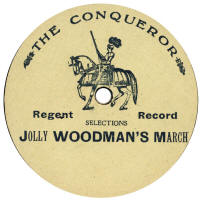 |
| Conquest (1) |
A solitary 6" record recorded and
manufactured by the Gramophone Company on behalf of British Homophone,
for sale in Woolworths. The catalogue number started at 2001-D and seem to have ended there, too! It appears to be a trial that failed, possibly because Woolworths were expecting an electrically recorded disc they could sell for 6d. It is thought this was not possible owing to the copyright fee which the record company would have had to pay to the Western Electric company making it uneconomical. |
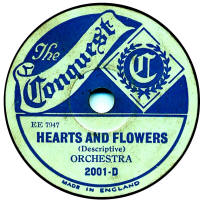 |
| Conquest (2) |
In late 1956, The World Record Club
organisation decided to try and enter the retail record market, and so
launched the "Conquest" label. The label name came about from the fact that the two men in charge were Norman Newell and Norman Lonsdale. Hence Normans' Conquest! The first record was issued in December 1956, followed by a batch of 4 in January 1957. The company ran into difficulties almost straight away when they found that, although interest from the pubic was promising, the retailers and wholesalers were apathetic towards stocking the label. After another batch of issues in April 1957 and a couple in the summer, the label languished, only to have a brief revival in January 1959 with an issue of strict dance tempo records, after which the label was shelved. As well as the 18 78rpm records issued, there were also a number of 45s, EPs & LPs, all issued at the same time as the 78s. Catalogue numbers of the 78s ran from CP-101 to CP-118, and the records were pressed by Phillips Electrical Ltd. In November 1969, two 45rpm singles were issued on Conquest before the label disappeared forever. Thanks to Bill Dean-Myatt for the label scan. |
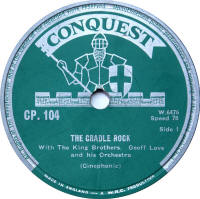 |
| Conroy |
A library music label produced for the Berry Music Company in the
late 1950s and into the 1960s, probably always pressed in Vinyl. The
catalogue series ran from BM-101 and had reached BM-437 by 1964, still at 78rpm speed. The following year they switched to 33rpm discs only, starting at BMLP-001. Thanks to Bill Dean-Myatt for the label scan, and to Paul Buck for details about the highest-known 78 and the change-over to LP. |
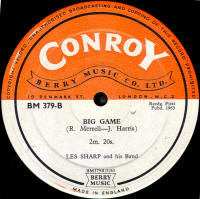 |
| Coral |
Originally a subsidiary label to Vogue and titled VOGUE CORAL SERIES in
the mid-1950s, then in the later 1950s, the label name was taken on by
Decca and they continued to use it until the 1970s (though obviously not
on 78rpm records by then). The 78s are all American recordings. Thanks to Bill Dean-Myatt for the label scan. |
|
| Coronet |
These were available for a short period
in early 1917 and were made by Crystalate using Invicta masters. They were
sold by Curwen's, the music publisher. In fact, no Coronet record has
yet been found, though an advert at the time says 100 different discs
were available on this label. Unfortunately for Curwen's, the name
"Coronet" was already registered to Pathe Freres, so the stock of their
Coronet records had to be withdrawn. They were then re-pressed and
issued on the Neptune label. Any details and/or a label scan would be gratefully received. |
|
| Cow Boy Brand | This label was sent into the editor of "For The Record" No. 28, from a member in Hong Kong, but nothing more is known about it despite it being "Made in England" according to the label. |
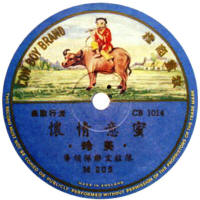 |
| Crescent (Paste-over) |
I know nothing about who was selling these records. The "Crescent" is a paste-over label covering the top half of a Regal record. This Regal was on sale from 1917 to 1921, so maybe this proprietor was selling off old-stock during the early 1920s. Thanks to Chris MacDonald for the label scan. |
_small.jpg) |
| Cricket |
A 7" Children's record believed to date
from the early 1960s and therefore probably made from plastic. There is an
American label of the same name issuing the same recordings, and many are
also found on the "Happy Time" label, both in the UK and US. Thanks to Bill Dean-Myatt for the label scan. |
 |
| Criterion |
The Sound Recording
Company registered the name 'Criterion' for use on records in 1913, but
never seems to have used the name on properly pressed labels, but only as
a partial paste-over (see image) on existing records, right up into the
1920s. Thanks to Ray Stephenson for the label photo. |
_small.jpg) |
| Crown |
The earliest Crown record dates from
pre-WWI and was pressed by Polyphon using their own masters.
Then, in the mid-1920s, Edison Bell used the name for a 6" disc as a replacement for their 6" "Bell" records, but it was quite short-lived. There was a blue-labelled equivalent, labelled Crown Picturegram as well. Then, in 1935, Crystalate produced Crown as a 9" record sale by F. W. Woolworths at 6d (2.5p) from 1935 to 1937. With the exception of a few items which were dubbed from US ARC masters, all these Crowns use UK masters recorded specifically for the label by Crystalate. Dance bands include Mrs Jack Hylton (Ennis Parkes), Billy Merrin and Jay Wilbur's band under many different pseudonyms. Harry Bidgood recorded his accordion band (using the name "Rossini") and there were many popular singers, including Vera Lynn, Donald Peers and Jenny Howard. They also produced a short series of
Nursery records .
|
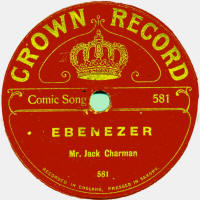 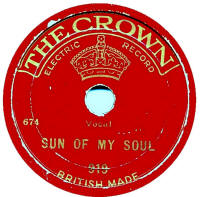 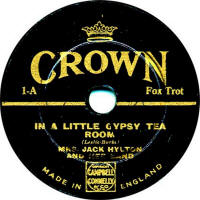 |
| Crown Perfect | The Crown Perfect label was a paste-over stuck on old-stock single-faced Columbia records dating from pre-1910. These Crown Perfect recoreds were sold by Selfridge's department store in London and it may have been a way of clearing out the old single faced records once the double-faced ones were on sale. |
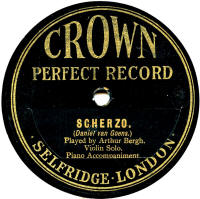 |
| Crystalate |
The
well-known manufacturing company and, later, recording company only
briefly issued records under their own name, instead of the more
familiar Popular, Imperial, Rex &c. The 12" Crystalate records were
issued in 1932 in a Z-100 series, but after only a few months, the
company decided to use the usual Imperial label for these issues
instead. The company also used the Crystalate name for issues of their 7" Victory records in France (second image). Thanks to Bill Dean-Myatt for the first label scan. |
|
| CTC |
CTC stands for
"Cape to Cairo", from which I assume the CTC Bazaars were a chain of
stores operating in Africa. This record is a 6" record using "Little
Marvel" masters from English Vocalion which date from the 1920s. Thanks to Rainer Lotz for the label scan |
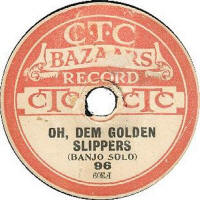 |
| Curry's |
Curry's
were bicycle manufacturers originally, starting in 1884. I assume that,
like now, they had many branches around the country. However, like many
bicycle shops at the start of the 20th century, they started selling
records and gramophones too. The difference was that they decided to
have their own record labels too. Apart from the ones here, with their
own name, they also sold "Portland" and "Westport"
records exclusively as well. Whether they also sold the standard record
labels, I have no idea. The first "Curry's" records were pressed by Edison Bell using matrices available on their "Bell" and "Winner" label (some were just "paste-overs"). They probably date from 1911, and are likely to have been quite short-lived as they are very scarce, even compared to "Bell Discs" from which they were derived. (See first example, right.) From just after the end of the Great War, Crystalate started producing the Curry's label. They produced two series, both with yellow labels. The first series used Invicta/Guardsman masters (including aome from American Gennett) (see second example right), with a catalogue series running from 1 to just over 100 and dating from about 1919 to 1921. They then started another series, using the 2nd yellow label design (3rd image right) and using their own masters (i.e. from Grammavox, Popular and then Imperial, the latter also including American recordings from the ARC/Plaza group). Records were usually issued under pseudonyms (almost all dance records issued as Curry's Dance Orch). The catalogue numbering started (again) at 1, and reached about 350 before they were withdrawn. Subsequently, Curry's records use a paste-over label on Piccadilly records (see fourth example), probably to sell old stock, until around 1929. The records were probably sold for 1/- to 1/6 (5p - 7.5p). These show the same catalogue number & artist credit as the original Piccadilly issue. It is not known how many Piccadilly records were overlabelled in this manner, but from my experience, the concentration is on the earlier records - the highest I have is number 452.
The scan of the first yellow Curry's
label has been taken from Steven Walker's excellent
"English
Ragtime" discography. For anyone
interested in this subject, quite apart from the well-researched
discographical information, the book has some superb label scans in full
colour and many monochrome photographic reproductions of the artists.
|
 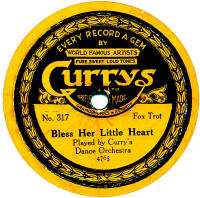 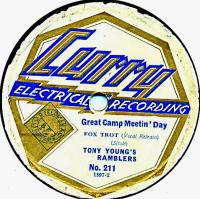 |
| Curwen |
Curwen were music publishers
and this label was an outlet for some of their music. The records were
recorded and pressed by Synchrophone, who were also producing Octacros
records, which have a similarly-designed label, and date from 1934. Thanks to Greg Butler for the label scan. |
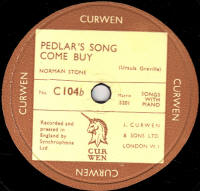 |
| Cymot |
An extremely scarce
label from the Vocalion stable from the early 1920s. Note the similarity
in design to the equally rare "Adelphi" label, also from Vocalion which
dates from later in the 1920s. It is not know the proprietor for Adelphi
Records yet, but Cymot records are most likley to have been made for
export to South Africa to be sold by Cymot Ltd of Cape Town (who took
their name from The Cycle and Motor Trade Supply Company). On a recent visit (2017) to South Africa, collector Steve Paget actually found a Cymot, which gives weight to this theory, and well-known researcher Rainer Lotz said that the only two he had found also came from South Africa.. Please e-mail me with details of ANY of these records. My thanks to Rainer Lotz for this label scan. |
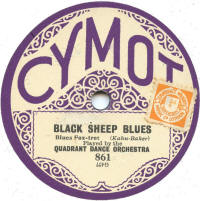 |